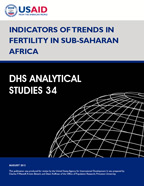- PUBLICATIONS
- JOURNAL ARTICLES
- ORDER PUBLICATIONS
Publications Summary
- Document Type
- Analytical Studies
- Publication Topic(s)
- Fertility and Fertility Preferences
- Language
- English
- Recommended Citation
- Westoff, Charles F., Kristin Bietsch, and Dawn Koffman. 2013. Indicators of Trends in Fertility in Sub-Saharan Africa. DHS Analytical Studies No. 34. Calverton, Maryland, USA: ICF International.
- Download Citation
- RIS format / Text format / Endnote format
- Publication Date
- August 2013
- Publication ID
- AS34
Download
 Indicators of Trends in Fertility in Sub-Saharan Africa (PDF, 1729K)
Indicators of Trends in Fertility in Sub-Saharan Africa (PDF, 1729K)
